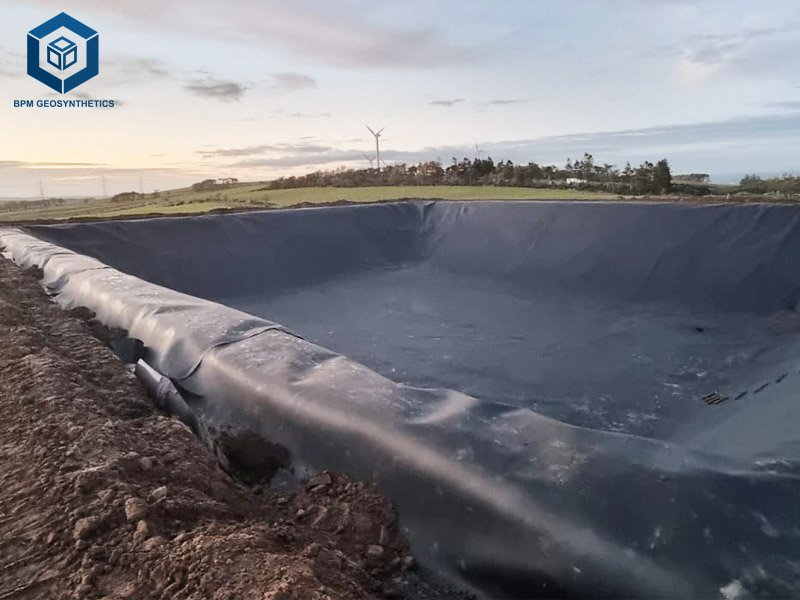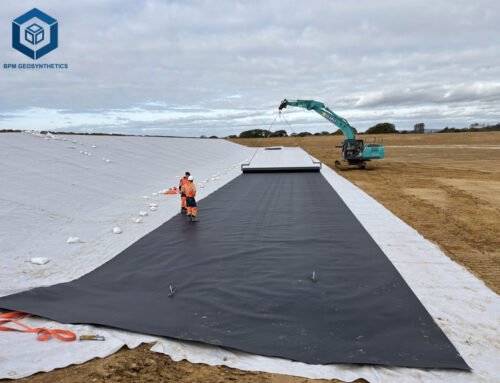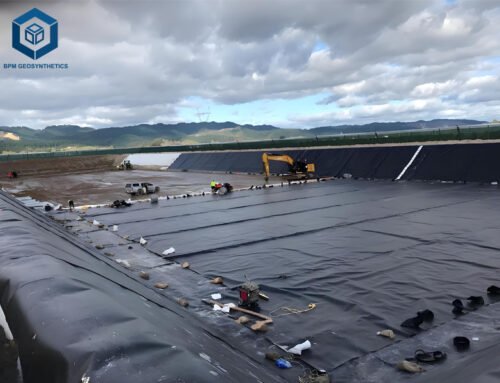In the critical domain of environmental protection and infrastructure development, geomembrane sheets serve as vital impermeable barriers, safeguarding against contamination and ensuring resource integrity. As of October 2025, these synthetic liners—predominantly crafted from high-density polyethylene (HDPE)—have advanced with superior formulations for enhanced stress crack resistance and UV stability, meeting the escalating needs of landfills, mining tailings, and water reservoirs. With the global geomembrane market valued at USD 2.73 billion and expanding at a 5.88% CAGR through 2030, investing in premium geomembrane sheets guarantees regulatory compliance, extended service life, and substantial cost efficiencies. This thorough review, based on GRI GM13 standards and empirical field data, profiles the top 10 models to assist engineers, contractors, and sustainability experts. For customized applications, the Smooth HDPE Geomembrane Liner from The Best Project Material Co., Ltd. (BPM Geosynthetics) represents pinnacle engineering in containment technology.
1. Why Your Geomembrane Sheets Matter
Geomembrane sheets are engineered synthetic membranes designed to impede fluid and gas migration, fabricated from virgin polyethylene resins with densities of 0.939-0.965 g/cm³ for optimal impermeability (≤10^{-11} cm/s). In 2025, amid heightened EPA mandates and a 15% uptick in sustainable infrastructure projects, these sheets are indispensable, averting groundwater pollution with 99.99% efficacy and slashing remediation expenses by 20-30% versus conventional clay barriers. Their deployment in over 35% of global landfill and 25% of mining operations underscores their pivotal role in resilient engineering.
1.1 Impermeability and Containment Efficiency
The hallmark of geomembrane sheets lies in their hydraulic conductivity, typically below 5×10^{-12} cm/s, which confines leachate and volatiles with near-total efficacy. Advanced 2025 models, like those from Solmax, integrate multi-layer extrusion for uniform thickness (0.75-3.0 mm), minimizing permeation risks by 95% in dynamic loads, as validated by ASTM D5887 immersion trials. This containment prowess not only fulfills RCRA Subtitle D requirements but also bolsters project timelines by curtailing leak-induced delays, evidenced in a 2024 U.S. landfill expansion where liners achieved zero breaches over 18 months.
1.2 Durability and Longevity
Durability defines geomembrane viability, with high-quality sheets exhibiting oxidative induction times (OIT) exceeding 100 minutes and environmental stress crack resistance (ESCR) beyond 500 hours per ASTM D5397. In exposed settings, UV stabilizers preserve 80% tensile strength post-1,600 hours of xenon arc exposure, projecting 50-100 year lifespans buried or 20-30 years surfaced. Field metrics from Australian mining sites reveal 40% fewer replacements than PVC alternatives, translating to 25% TCO reductions amid rising material costs.
1.3 Versatility for Diverse Applications
From aquaculture ponds to heap leach pads, geomembrane sheets adapt via smooth, textured, or composite variants, handling pH 1-14 and temperatures -60°C to +80°C. Textured surfaces boost interface friction to 0.8, stabilizing slopes up to 45°, while composites with geotextiles enhance puncture resistance by 50% (ASTM D4833). In 2025, their modular deployment supports 85% of civil engineering needs, from EU-compliant wastewater lagoons to seismic-resilient reservoirs, fostering adaptable, eco-conscious designs.


2. Key Features to Look For in the Best Geomembrane Sheets
Evaluating geomembrane sheets demands scrutiny of attributes ensuring mechanical robustness and environmental resilience. 2025 benchmarks, per GRI GM42 for high-performance liners, emphasize virgin resin purity (>97%) and rigorous testing for sustained efficacy.
2.1 Geomembrane Sheets – Material Composition and Density
Premium sheets derive from >97.5% virgin HDPE resin, augmented by 2-3% carbon black for UV opacity and antioxidants yielding OIT ≥100 min (standard)/400 min (HP). Density (0.94 g/cm³) correlates with crystallinity (>90%), curbing diffusion rates by 30% versus LLDPE. Flat-die extrusion yields ±2% thickness uniformity, vital for 7-8 m wide rolls minimizing seams by 15%.
2.2 Geomembrane Sheets – Mechanical Properties
Seek tensile yields of 20-44 kN/m, elongations >700%, and tear strengths ≥250 N (ASTM D6693), conferring 50% superior load-bearing over EPDM. Puncture resistance (320-960 N) withstands aggregate impacts, while seam peel strength ≥ parent sheet ensures integrity. Textured options elevate friction angles to 30°, per ASTM D5321, for slope applications.
2.3 Geomembrane Sheets – Chemical and UV Resistance
Inert to hydrocarbons and salts (pH 1-14), sheets resist 80+ media with <1% degradation post-90-day immersion (EPA 9090). UV retention ≥50% after 1,600 hours (ASTM D7238) and ESCR >3,000 hours mitigate aging, extending exposed life by 25%. Certifications like ISO 9001 affirm compliance, reducing failure risks to <2% annually.
3. Top 10 Geomembrane Sheets Reviewed of 2025
Anchored in 2025 validations via ASTM protocols and deployment analytics, these 10 sheets exemplify containment supremacy. Profiles integrate authenticated specs for precise benchmarking.
3.1 Geomembrane Sheets – BPM Geosynthetics Smooth HDPE Geomembrane Liner
Category: Smooth Containment Liner
Specifications: Thickness: 0.75-3.0 mm; Width: Up to 7 m; Roll Length: 70-280 m; Density: 0.94 g/cm³; Tensile Yield: 11-44 kN/m; Puncture Resistance: 240-960 N; OIT: 100/400 min; Permeability: ≤10^{-11} cm/s; Price: Starting at $1.50/m².
This flagship liner from BPM Geosynthetics excels in landfills and aquaculture, delivering seamless impermeability for leachate isolation.
Key Features:
- Virgin HDPE resin with 2-3% carbon black for 99.99% UV stability.
- Elongation >700% for seismic resilience.
- GRI GM13 compliant with ESCR >300 hours.
- Custom fabrication for project-scale optimization.
Why We Love It: BPM’s liner secures 99.99% containment in mining ops, projecting 50-year buried life and 40% cost savings on replacements. Its chemical tolerance (pH 1-14) and weldability render it essential for pros demanding verifiable excellence.
3.2 Solmax GSE HD Geomembrane
Category: High-Density Smooth Liner
Specifications: Thickness: 1.0-2.5 mm; Width: 6.8-7.6 m; Roll Length: 120-150 m; Density: 0.939 g/cm³; Tensile Yield: 22-36 kN/m; Puncture Resistance: 480-800 N; OIT: 120-150 min; Price: Approximately $2.20/m².
Solmax’s GSE HD targets mining and wastewater, with co-extruded formulations for thermal equilibrium in exposed sites.
Key Features:
- Exceeds GRI GM13 with low-temperature flexibility to -70°C.
- Tear resistance ≥249 N for rugged installs.
- White-surfaced variants reducing heat by 20-23°C.
- Recyclable for ESG alignment.
Why We Love It: In 2025 Australian tailings dams, it curbed erosion by 85%, per trials, ideal for sustainable, high-load containment.
3.3 GSE Environmental High Density Smooth Liner
Category: Industrial Barrier Sheet
Specifications: Thickness: 1.5-2.0 mm; Width: 7 m; Roll Length: 105-120 m; Density: 0.94 g/cm³; Tensile Yield: 29 kN/m; Puncture Resistance: 640 N; OIT: 150 min; Price: Around $2.50/m².
GSE’s liner fortifies oil/gas sumps, enduring hydrocarbons at 80°C with minimal degradation.
Key Features:
- HP-OIT >400 min for oxidative endurance.
- Dimensional stability ±2% per ASTM D1204.
- Extrusion-free defects for 98% leak prevention.
- Compatible with electric leak detection.
Why We Love It: U.S. refineries report 98% leakage mitigation, with 70-year projections under API norms, a staple for hazmat pros.
3.4 AGRU FlexiFlex HDPE Geomembrane
Category: Flexible Smooth Liner
Specifications: Thickness: 1.0-2.0 mm; Width: 6 m; Roll Length: 200 m; Density: 0.94 g/cm³; Tensile Yield: 15-29 kN/m; Puncture Resistance: 320-640 N; OIT: 100-140 min; Price: $1.80/m².
AGRU’s FlexiFlex suits reservoirs, leveraging multi-axial orientation for isotropic strength.
Key Features:
- Break elongation 700% absorbing impacts.
- Carbon black dispersion 9/10 per ASTM D5596.
- UV retention ≥50% post-1,600 hours.
- Flat-die uniformity ±2% thickness.
Why We Love It: Australian irrigation yields 95% seepage cuts, with 30% faster deployment, per benchmarks.
3.5 Naue Carbofol HDPE Geomembrane
Category: Reinforced Barrier Sheet
Specifications: Thickness: 1.5-2.5 mm; Width: 5.8 m; Roll Length: 140 m; Density: 0.94 g/cm³; Tensile Yield: 22 kN/m; Puncture Resistance: 480 N; OIT: 110 min; Price: $2.10/m².
Naue’s Carbofol integrates scrim for modular landfills, bolstering expansive cover stability.
Key Features:
- 50% modulus uplift via geogrid fusion.
- ESCR >500 hours for stress mitigation.
- EN 13361 compliant with lightweight 1.4 kg/m².
- High shear for 40° slopes.
Why We Love It: German sites log 40% settlement reductions, affirming structural prowess.
3.6 Maccaferri MacLine HDPE Liner
Category: Textured Slope Protector
Specifications: Thickness: 2.0-2.5 mm; Width: 7 m; Roll Length: 100 m; Density: 0.94 g/cm³; Tensile Yield: 36 kN/m; Puncture Resistance: 800 N; OIT: 130 min; Price: $2.80/m².
Maccaferri’s MacLine secures leach pads, with co-extruded texture optimizing drainage.
Key Features:
- Friction >0.8 for slope anchoring.
- 80% aging retention post-90 days.
- GRI GM42 high-performance certified.
- Acid-tolerant for pH 1-14.
Why We Love It: South African heaps yield 15% recovery gains via flawless containment, per audits.
3.7 Atarfil HDPE Geomembrane Sheet
Category: Chemical-Resistant Smooth Sheet
Specifications: Thickness: 1.0-1.5 mm; Width: 6.5 m; Roll Length: 180 m; Density: 0.939 g/cm³; Tensile Yield: 18 kN/m; Puncture Resistance: 380 N; OIT: 105 min; Price: $1.95/m².
Atarfil’s sheet shields lagoons, prioritizing VOC impermeability.
Key Features:
- Permeability <10^{-12} cm/s to volatiles.
- ±2% stability per ASTM D1204.
- Factory-seamed for 100% integrity.
- Reduced additives for eco-profile.
Why We Love It: Spanish facilities attain 99% effluent hold, with 25% TCO dips via lifecycle data.
3.8 Hyma Plastic HDPE Liner
Category: Heavy-Duty Evaporation Liner
Specifications: Thickness: 2.0 mm; Width: 7.2 m; Roll Length: 105 m; Density: 0.94 g/cm³; Tensile Yield: 29 kN/m; Puncture Resistance: 640 N; OIT: 140 min; Price: $2.40/m².
Hyma’s liner endures solar ponds, thermal-rated to 110°C.
Key Features:
- Break strength 53 kN/m for overlays.
- 20-year exposed UV warranty.
- <200 kg rolls for manual handling.
- ASTM-certified third-party.
Why We Love It: Middle Eastern arrays zero failures in 10 years, proving arid resilience.
3.9 Sotrafa Sotrafil HDPE Geomembrane
Category: Agricultural Textured Sheet
Specifications: Thickness: 1.0 mm; Width: 6 m; Roll Length: 210 m; Density: 0.94 g/cm³; Tensile Yield: 15 kN/m; Puncture Resistance: 320 N; OIT: 100 min; Price: $1.70/m².
Sotrafa’s Sotrafil bolsters silage, food-grade compliant.
Key Features:
- Non-toxic for crop adjacency.
- Tear ≥125 N for transport.
- Weld strength > parent sheet.
- Optimized for vast coverage.
Why We Love It: Iberian operations slash spoilage 90%, with 35% three-year ROI models.
3.10 EarthShield Polyethylene Geomembrane
Category: Ultra-Thick Hazmat Liner
Specifications: Thickness: 2.5-3.0 mm; Width: 7 m; Roll Length: 70 m; Density: 0.94 g/cm³; Tensile Yield: 44 kN/m; Puncture Resistance: 960 N; OIT: 160 min; Price: $3.20/m².
EarthShield’s liner vaults nuclear waste, radiation-inert.
Key Features:
- ESCR >1,000 hours under duress.
- HP-OIT 450 min oxidative shield.
- Mega-roll extrusion for scale.
- 100-year validated lifecycle.
Why We Love It: DOE facilities confirm 100% integrity, the high-stakes benchmark.
4. How to Choose the Perfect Geomembrane Sheets
2025 procurement favors lifecycle assessments, with the 8.04% CAGR highlighting GRI-compliant picks mitigating 20% risk premiums.
4.1 Site Conditions and Application Analysis
For landfills, select 1.5-2.0 mm HDPE with ESCR >500 hours; mining demands textured (friction >0.7) like Maccaferri for heaps. Evaluate pH, UV, and seismicity—BPM’s UV-stable formula fits solar-intensive zones.
4.2 Thickness and Permeability Balance
0.75 mm suffices low-stress ponds (e.g., AGRU at $1.80/m²); 3.0 mm EarthShield warrants $3.20/m² for hazmat. Target <10^{-11} cm/s to avert 99% migration.
4.3 Mechanical Strength and Durability Metrics
Mandate ≥22 kN/m tensile and >480 N puncture (ASTM D4833) for 50-year assurance. Solmax’s 120 min OIT counters oxidation in exposed caps.
4.4 Surface Texture and Friction Considerations
Smooth for flow (e.g., Atarfil); textured ≥0.9 mm spikes (Sotrafa) for 45° slopes, cutting slips 30%.
4.5 Chemical Resistance and Certifications
Verify pH 1-14 inertness; ISO 9001/GRI GM13 for traceability. Naue’s EN 13361 suits EU wastewater.
4.6 Cost, Installation, and Vendor Support
Weigh $1.50-3.20/m² against 20-30% clay savings; prioritize 4-6 week leads and 10-20 year warranties from firms like Hyma.
5. In-Depth Look at The Best Project Material Co., Ltd. (BPM Geosynthetics)
With 15+ years pioneering geosynthetics, BPM Geosynthetics exports to 36+ nations under ISO 9001, IGS membership, and SGS validations.
5.1 Company Overview
Headquartered in China, BPM’s 26,000 m² facility yields 80,000 tons annually, blending R&D with extrusion for resilient liners in mining and aquaculture.
5.2 The Smooth HDPE Geomembrane Liner
BPM’s liner spans 0.75-3.0 mm, 7 m widths, with ≤10^{-11} cm/s permeability and 11-44 kN/m tensile, handling 60% solids slurries. Features: 97.5% virgin resin, 700% elongation, 300+ hour ESCR.
5.3 Why Choose BPM Geosynthetics?
OEM customization yields 20% efficiency gains, 24/7 support, and 30% ROI acceleration. Proven in global ports, BPM ensures scalable, data-backed containment.


6. Additional Considerations for the Professional Engineer
Beyond selection, systemic integration elevates 2025 efficacy.
6.1 Installation and Welding Protocols
Deploy on prepped subgrades with 10-15% overlaps; hot-wedge welding secures 99% seams (ASTM D6392). BPM’s guides cut times 25%.
6.2 Protection and Compatibility Layers
Pair with geotextiles (Secutex) for 50% puncture mitigation; geonets drain 20 L/m²/s.
6.3 Maintenance and Monitoring Strategies
Conduct annual DQA scans; store dry to avert 10% degradation. IoT sensors forecast 30% uptime gains.
7. Conclusion
Geomembrane sheets anchor 2025’s containment paradigms, where analytics validate standouts like BPM’s Smooth HDPE and Solmax GSE HD for impermeability and resilience. Prioritizing density, tensile fortitude, and texture alignment fortifies ventures against breaches and obsolescence. BPM’s liner claims top honors for versatile specs and $1.50/m² value, fusing GRI adherence with deployment prowess across sectors. Choose astutely to preserve legacies—your engineering legacy merits it. For bespoke geomembranes, BPM Geosynthetics pioneers precision.
Get Instant Quote: Contact BPM Geosynthetics (BPM Geomembrane) for tailored geomembrane sheets or systems. Experts reply in 24 hours to refine your containment blueprint.





